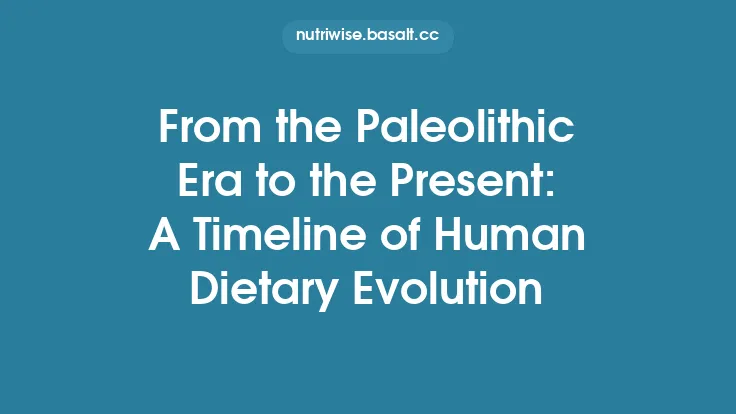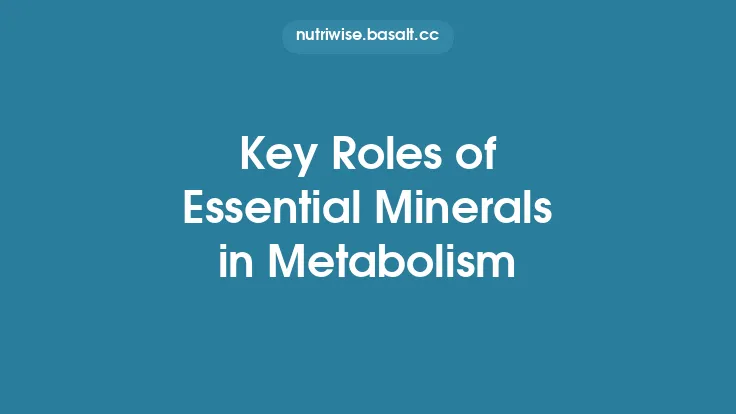Essential minerals are the inorganic building blocks that the human body cannot synthesize on its own and must therefore obtain from the external environment. Though required only in minute quantities compared with macronutrients such as carbohydrates, proteins, and fats, these trace elements are indispensable for the structural integrity of tissues, the activity of enzymes, and the maintenance of physiological equilibrium. Their presence underpins virtually every biological system, from the formation of bone matrix to the regulation of nerve impulse transmission. Understanding the foundational concepts surrounding essential minerals provides a solid platform for anyone interested in nutrition science, public health, or clinical practice.
Defining Essential Minerals
An essential mineral meets three criteria established by nutritional science:
- Physiological Necessity – The element must play a non‑redundant role in normal body function. If the mineral is removed from the diet, a measurable decline in health or performance occurs.
- Irreplaceability by Other Nutrients – No combination of other nutrients can fully compensate for the loss of the mineral’s specific biochemical actions.
- Deficiency Manifestation – A clear, reproducible set of clinical or sub‑clinical signs appears when intake falls below a threshold, and these signs are reversible upon repletion.
These criteria differentiate essential minerals from non‑essential trace elements that may be present in the diet but do not have a defined biological role, such as certain heavy metals.
Classification and Distinction from Other Elements
Essential minerals are traditionally grouped into two categories based on the quantities required:
| Category | Typical Daily Requirement | Representative Elements |
|---|---|---|
| Macrominerals | >100 mg per day | Calcium, phosphorus, magnesium, sodium, potassium, chloride, sulfur |
| Trace Minerals | 1–100 mg per day | Iron, zinc, copper, manganese, selenium, iodine, chromium, molybdenum, fluoride |
The distinction is not merely quantitative; macrominerals often serve structural or osmotic functions (e.g., calcium in bone, sodium in extracellular fluid balance), whereas trace minerals are frequently cofactors for enzymes or participants in redox reactions. Both groups, however, share the characteristic of being essential and must be supplied through diet or, in specific clinical circumstances, via supplementation.
Historical Context of Mineral Nutrition
The recognition of minerals as vital nutrients dates back to the 18th and 19th centuries, when physicians observed that certain disease patterns could be alleviated by mineral‑rich substances. Notable milestones include:
- James Lind’s 1747 scurvy experiments, which highlighted the preventive effect of citrus fruits rich in vitamin C and, indirectly, the importance of dietary minerals in wound healing.
- The discovery of iodine’s role in goiter prevention by Coindet in 1820, establishing a direct link between a trace element and endocrine health.
- The identification of iron deficiency anemia in the late 19th century, which spurred the development of iron fortification programs.
These historical observations laid the groundwork for modern nutritional biochemistry, where sophisticated analytical techniques now allow precise quantification of mineral concentrations in biological fluids and tissues.
Primary Dietary Sources and Food Patterns
While the specific food matrix influences mineral bioavailability, several broad food groups consistently provide the bulk of essential minerals:
- Dairy and fortified plant milks – Rich in calcium, phosphorus, and magnesium.
- Whole grains and legumes – Principal sources of magnesium, phosphorus, zinc, and copper.
- Seafood and marine algae – High in iodine, selenium, and trace amounts of zinc and copper.
- Meat, poultry, and organ meats – Concentrated sources of iron (especially heme iron), zinc, and copper.
- Nuts, seeds, and dried fruits – Provide magnesium, manganese, and trace amounts of selenium.
Food processing methods, such as milling, can reduce mineral content by removing the bran and germ layers where many minerals are concentrated. Conversely, fortification and enrichment practices—adding minerals back into refined products—help mitigate these losses on a population level.
Factors Influencing Mineral Status
A multitude of variables modulate the relationship between dietary intake and physiological status:
- Gastrointestinal Absorption Efficiency – Although detailed mechanisms of absorption are beyond the scope of this overview, it is important to recognize that factors such as gastric acidity, intestinal transit time, and the presence of competing ligands can affect how much of an ingested mineral reaches systemic circulation.
- Physiological Life Stages – Growth periods (infancy, adolescence), pregnancy, and aging each impose distinct mineral demands due to changes in tissue turnover, hormonal regulation, and renal function.
- Genetic Polymorphisms – Variants in transport proteins (e.g., DMT1 for iron) or metallothioneins can alter individual susceptibility to deficiency or excess.
- Health Status and Medications – Chronic kidney disease, gastrointestinal disorders (e.g., celiac disease), and certain diuretics can lead to altered mineral excretion or loss.
- Environmental Exposure – Soil mineral composition influences the mineral content of plant foods, while water hardness contributes to calcium and magnesium intake.
Understanding these determinants is essential for interpreting population surveys and for tailoring interventions to specific sub‑groups.
Assessment and Biomarkers of Mineral Adequacy
Evaluating mineral status involves a combination of dietary assessment, biochemical measurement, and clinical observation:
- Dietary Surveys – 24‑hour recalls, food frequency questionnaires, and diet records provide estimates of intake but are limited by reporting bias and food composition database accuracy.
- Biochemical Indicators – Serum or plasma concentrations (e.g., serum calcium, serum ferritin for iron stores) are the most common laboratory markers. For some trace minerals, urinary excretion rates (e.g., urinary iodine) serve as reliable proxies of recent intake.
- Functional Tests – Enzyme activity assays (e.g., superoxide dismutase activity for zinc and copper) can reflect the functional adequacy of certain minerals.
- Clinical Signs – Physical manifestations such as nail changes, hair loss, or specific dermatological findings may hint at underlying mineral imbalances, though they are rarely specific.
A comprehensive assessment typically integrates multiple data sources to overcome the limitations inherent in any single method.
Public Health Perspectives and Policy Frameworks
From a population health standpoint, essential minerals are addressed through several coordinated strategies:
- Food Fortification – Adding minerals to staple foods (e.g., iodized salt, iron‑fortified flour) has proven effective in reducing deficiency prevalence on a national scale.
- Supplementation Programs – Targeted distribution of mineral supplements to vulnerable groups (e.g., pregnant women, young children) complements fortification efforts.
- Regulatory Standards – Agencies such as the World Health Organization (WHO) and national food safety authorities establish maximum permissible levels for both essential and potentially toxic minerals, ensuring safety while preventing inadvertent excess.
- Surveillance Systems – Periodic national nutrition surveys monitor trends in mineral intake and status, informing policy adjustments and resource allocation.
These interventions are designed to be sustainable, culturally appropriate, and adaptable to varying socioeconomic contexts.
Research Methodologies in Mineral Nutrition
Advancing knowledge about essential minerals relies on a spectrum of scientific approaches:
- Epidemiological Cohort Studies – Longitudinal tracking of dietary intake and health outcomes helps elucidate associations between mineral status and disease risk.
- Randomized Controlled Trials (RCTs) – Intervention trials that manipulate mineral intake provide causal evidence regarding efficacy and safety.
- Metabolomics and Trace Elementomics – High‑throughput analytical platforms (e.g., inductively coupled plasma mass spectrometry) enable comprehensive profiling of mineral concentrations across biological matrices.
- Animal Models – Controlled feeding studies in rodents or larger mammals allow mechanistic exploration of mineral functions under defined conditions.
- In Silico Modeling – Computational simulations of mineral transport and distribution contribute to hypothesis generation and the interpretation of complex data sets.
Rigorous methodological standards, including appropriate blinding, randomization, and statistical power calculations, are essential to generate reliable, reproducible findings.
Emerging Topics and Future Directions
The field of essential mineral nutrition continues to evolve, with several promising avenues on the horizon:
- Personalized Nutrition – Integration of genomic data with mineral status may enable individualized recommendations that account for genetic predispositions to absorption or excretion differences.
- Sustainable Food Systems – As agricultural practices shift toward climate‑resilient crops, research is needed to ensure that mineral density in plant foods is maintained or enhanced.
- Nanotechnology‑Based Delivery – Nano‑encapsulation of minerals aims to improve bioavailability while minimizing gastrointestinal irritation, especially for iron and zinc.
- Microbiome Interactions – Emerging evidence suggests that gut microbial composition can influence mineral metabolism, opening possibilities for probiotic or prebiotic strategies to optimize status.
- Global Health Equity – Addressing disparities in mineral nutrition requires innovative financing mechanisms, community‑driven fortification models, and culturally tailored education campaigns.
Continued interdisciplinary collaboration among nutritionists, agronomists, clinicians, and policy makers will be pivotal in translating these advances into tangible health benefits.
By grounding the discussion in the fundamental concepts of what essential minerals are, how they are classified, and the broad factors that shape their presence in the human body, this overview equips readers with a durable framework for further exploration. Whether the interest lies in clinical practice, public health planning, or scientific research, a clear grasp of these foundational elements is indispensable for navigating the complex landscape of human nutrition.





